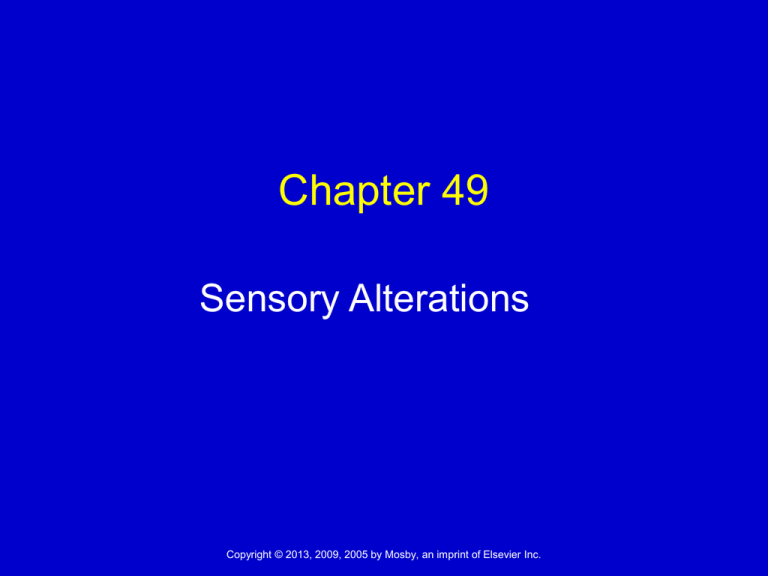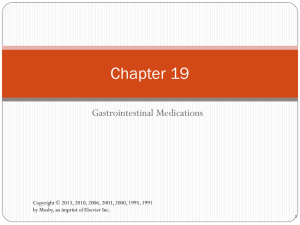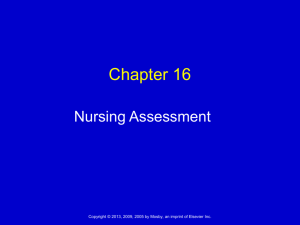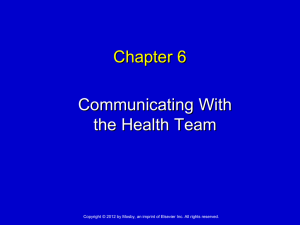receptive aphasia
advertisement

Chapter 49 Sensory Alterations Copyright © 2013, 2009, 2005 by Mosby, an imprint of Elsevier Inc. Terminology Senses: Sight/visual Hearing/auditory Touch/tactile Smell/olfactory Taste/gustatory Position and motion/kinesthetic Stereognosis is a sense that allows a person to recognize the size, shape, and texture of an object. Copyright © 2013, 2009, 2005 by Mosby, an imprint of Elsevier Inc. 2 Scientific Knowledge Base Sensory reception involves the stimulation of sensory nerve fibers and the transmission of impulses to higher centers within the brain. Normal sensation Reception: stimulation of a receptor such as light, touch, or sound Perception: integration and interpretation of stimuli Reaction: only the most important stimuli will elicit a reaction Copyright © 2013, 2009, 2005 by Mosby, an imprint of Elsevier Inc. 3 Case Study Mrs. Alicea is a 73-year-old woman who is at the senior health center for her routine 6-month checkup. She has been visiting the senior center on a regular basis for the past 8 years. Mrs. Alicea has lived alone since her husband died 1 year ago. She lives in a single-story, four-room home a few miles from the health center. Her son, Rico, lives 5 minutes away. Rico drives Mrs. Alicea to her visits. Six months ago, Mrs. Alicea reported progressive hearing loss. Today she reports “having trouble seeing.” Copyright © 2013, 2009, 2005 by Mosby, an imprint of Elsevier Inc. 4 Sensory Alterations Sensory deficits Sensory deprivation Deficit in the normal function of sensory reception and perception Inadequate quality or quantity of stimulation Sensory overload Reception of multiple sensory stimuli Copyright © 2013, 2009, 2005 by Mosby, an imprint of Elsevier Inc. 5 Nursing Knowledge Base: Factors Affecting Sensory Function Age Meaningful stimuli Various changes occur across the life span. Reduce the incidence of sensory deprivation Number of stimuli Social interaction Can cause sensory overload Increases with lack of socialization with family Environmental factors Cultural factors Occupation, recreation, and sports activities Sensory alterations occur in select groups. Copyright © 2013, 2009, 2005 by Mosby, an imprint of Elsevier Inc. 6 Case Study (cont’d) Peter Morris, a 33-year-old nursing student assigned to the senior center, is learning to conduct assessments and to develop health promotion plans for patients. For the past month, Peter has been attending his clinical rotation and participating in teaching health promotion activities. He is enjoying this rotation because he is learning more about geriatric patients and is finding that they are very independent and capable of having productive lifestyles. Copyright © 2013, 2009, 2005 by Mosby, an imprint of Elsevier Inc. 7 Critical Thinking + The Nursing Process Integrate pathophysiological knowledge about sensory deficits and factors affecting function Apply evidence-based standards of care: American Academy of Ophthalmology American Speech-Language-Hearing Association Include previous experiences: Assessment Nursing Diagnosis Planning Implementation Copyright © 2013, 2009, 2005 by Mosby, an imprint of Elsevier Inc. Evaluation 8 Assessment Persons at risk Sensory alteration history Mental status Physical assessment Ability to perform self-care Health promotion habits Environmental hazards Communication methods Social support Use of assistive devices Other factors affecting perception Copyright © 2013, 2009, 2005 by Mosby, an imprint of Elsevier Inc. 9 Case Study (cont’d) Mrs. Alicea reports that at her last visit to the ophthalmologist, she was told she had a cataract. Peter learns that Hispanic/Latino individuals in the United States have higher rates of visual impairment and blindness compared with members of other ethnic groups. Visual field loss has a negative impact on healthrelated quality of life: driving, distance and peripheral vision activities, and a sense of independence. Copyright © 2013, 2009, 2005 by Mosby, an imprint of Elsevier Inc. 10 Quick Quiz! 1. An elderly patient who lives in an adult assisted-living facility mentions that he is experiencing hearing and vision changes. During your assessment, you would associate this type of sensory deprivation with A. Stable affect. B. Altered perception. C. Improved task completion. D. Increased need for social interaction. Copyright © 2013, 2009, 2005 by Mosby, an imprint of Elsevier Inc. 11 Aphasia Definitions Patients with aphasia have varied degrees of inability to speak, interpret, or understand language. Expressive aphasia, a motor type of aphasia, is the inability to name common objects or express simple ideas in words or writing. Sensory or receptive aphasia is the inability to understand written or spoken language. Copyright © 2013, 2009, 2005 by Mosby, an imprint of Elsevier Inc. 12 Nursing Diagnosis (examples) Risk-prone health behavior Impaired verbal communication Risk for injury Impaired physical mobility Risk for falls Social isolation Bathing self-care deficit Dressing self-care deficit Toileting self-care deficit Situational low selfesteem Copyright © 2013, 2009, 2005 by Mosby, an imprint of Elsevier Inc. 13 Case Study (cont’d) Mrs. Alicea states, “I’m having difficulty reading and moving around the house. I cannot judge the steps clearly. I have difficulty judging distances between objects, which is worse at night.” Results of a home hazard assessment show that Mrs. Alicea’s home has dim lighting, stairs without handrails, and numerous throw rugs on the floor. What diagnosis do you think Peter will choose? Copyright © 2013, 2009, 2005 by Mosby, an imprint of Elsevier Inc. 14 Planning Include family members. Use standards as guides. Partner with the Make safety a top patient to set realistic priority. goals and achievable outcomes. Value other Consider communityprofessionals’ based resources. contributions. Copyright © 2013, 2009, 2005 by Mosby, an imprint of Elsevier Inc. 15 Case Study (cont’d) Goal: Mrs. Alicea’s home environment is safe and free of hazards within 4 weeks. What expected outcomes would you include? Copyright © 2013, 2009, 2005 by Mosby, an imprint of Elsevier Inc. 16 Implementation Patients can learn to adjust to sensory impairments at any age with the proper support and resources. Health promotion Screening Preventive safety (trauma, vaccines) Use of contact lenses, eyeglasses, hearing aids Promotion of meaningful stimuli Creating a safe environment Communication Copyright © 2013, 2009, 2005 by Mosby, an imprint of Elsevier Inc. 17 Acute Care Orientation to the environment Communication Control of stimuli Address the patient by name, place call light within reach, use nightlight, reduce clutter. Reduce sensory overload. Combine nursing activities. Control extraneous noise. Safety measures Copyright © 2013, 2009, 2005 by Mosby, an imprint of Elsevier Inc. 18 Safety Measures Copyright © 2013, 2009, 2005 by Mosby, an imprint of Elsevier Inc. 19 Restorative and Continuing Care Maintaining healthy lifestyles Understanding sensory loss Socialization Promoting self-care Increases self-esteem Enhances safety awareness Copyright © 2013, 2009, 2005 by Mosby, an imprint of Elsevier Inc. 20 Case Study (cont’d) What interventions would apply to these rationales? 1. Sensitivity to glare increases because of clouding of the lens. 2. Light intensity needs to be 3 times as powerful for older adults to produce the same visual acuity as for younger people. 3. Removal of trip hazards prevents falls and promotes a safe environment. What fall prevention interventions would Peter choose? Copyright © 2013, 2009, 2005 by Mosby, an imprint of Elsevier Inc. 21 Promoting Self-Care Copyright © 2013, 2009, 2005 by Mosby, an imprint of Elsevier Inc. 22 Quick Quiz! 2. A patient with glaucoma is being discharged from the hospital. When teaching the patient and family ways to improve home safety, the nurse tells the family to: A. Use throw rugs to prevent tripping. B. Paint the floor black and white to improve perception. C. Install extra incandescent lighting. D. Install handrails painted the same color as the walls. Copyright © 2013, 2009, 2005 by Mosby, an imprint of Elsevier Inc. 23 Case Study (cont’d) What nursing actions would be appropriate for Peter to take to evaluate Mrs. Alicea’s situation? Ask Mrs. Alicea at her next visit if she has experienced any trips or falls since modifications were made to her home. Ask Rico if his mother is having any difficulties moving through her home. Conduct a home visit, and reassess the home environment. Copyright © 2013, 2009, 2005 by Mosby, an imprint of Elsevier Inc. 24 Evaluation The patient is the only person who can tell you if sensory ability has improved as a result of nursing interventions. The patient is the only person who can tell you if sensory ability has improved as a result of nursing interventions. The patient is the only person who can tell you if sensory ability has improved as a result of nursing interventions. Copyright © 2013, 2009, 2005 by Mosby, an imprint of Elsevier Inc. 25




